1958 British Grand Prix report - British supremacy shattered
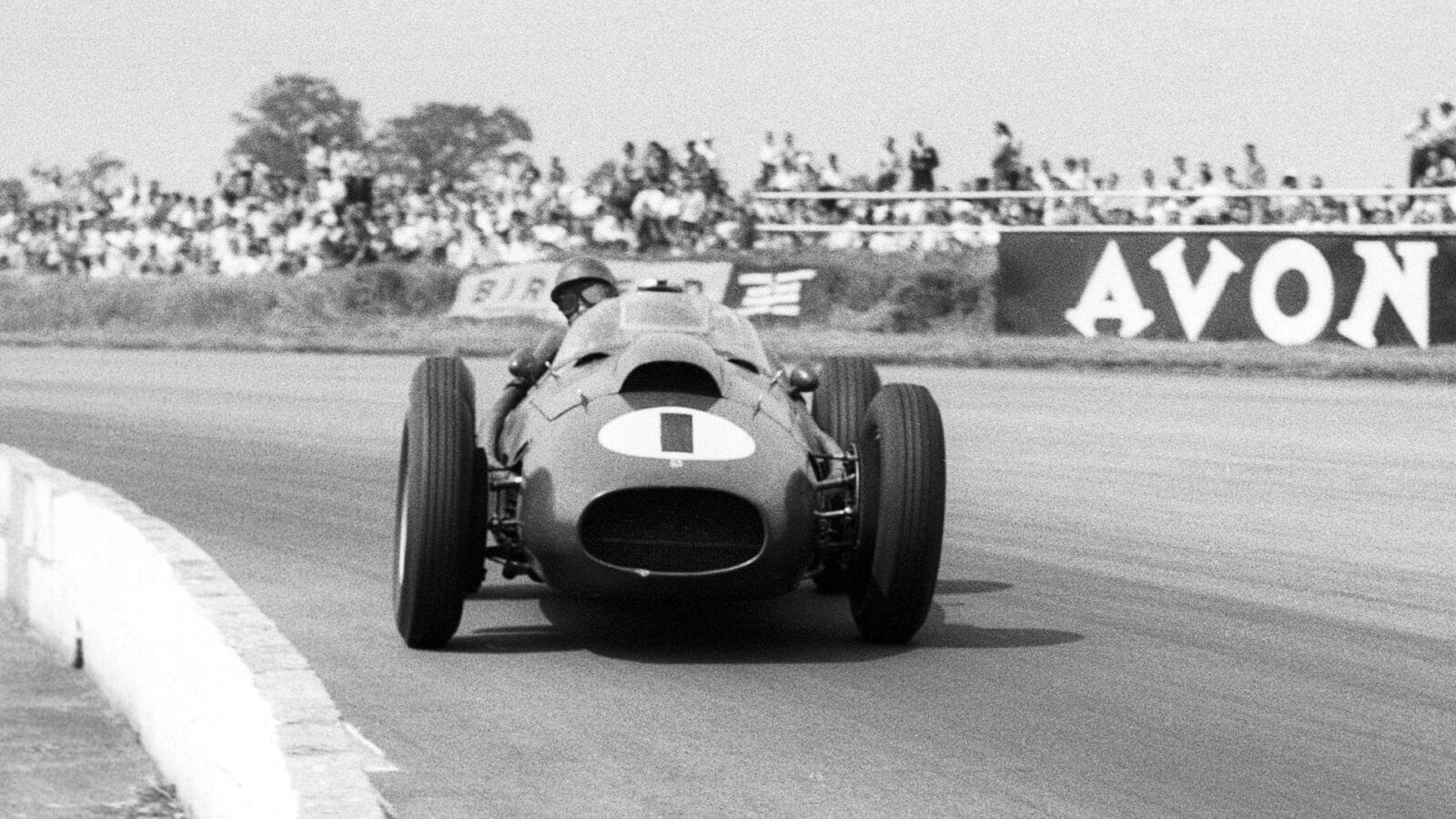
Sliding to victory: Collins on his way to a resounding win
Bernard Cahier/Getty Images
Silverstone, July 19th.
AFTER the defeat by Ferrari at Reims it seemed almost certain that Vanwall would regain their pride of place at Silverstone, their own home ground and a medium-fast circuit on which the Ferrari handling characteristics would not appear ideal. Added to this was the fact that Silverstone is not a circuit where high power and maximum speed are so important, as at Spa or Reims, while if Vanwall could not cope then it seemed that B.R.M. surely would, or even Cooper.
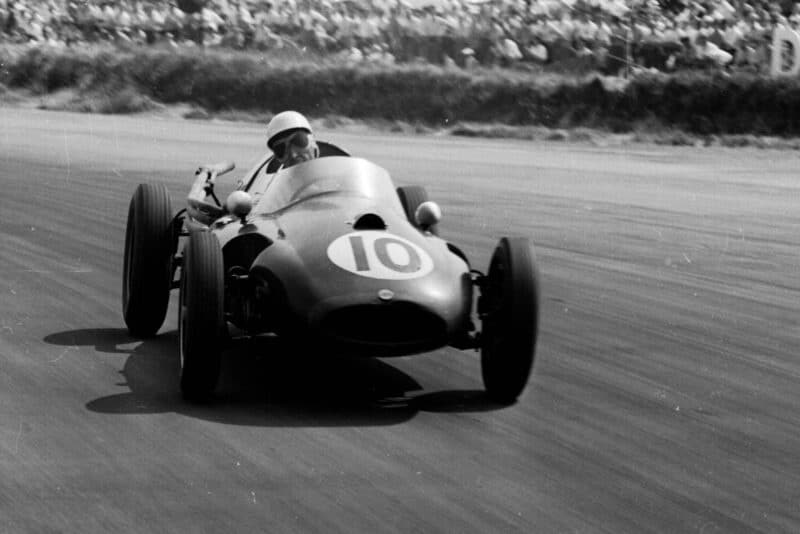
Roy Salvadori in his Cooper T45 Climax
Motorsport Images
Practice day on Thursday looked well, for Moss was easily fastest with the number one Vanwall, clocking 1 min. 39.4 sec., a fastest-ever lap of the Buckinghamshire circuit. To add weight, Brooks was next fastest, and altogether the Vanwall team seemed to be in command of things. On Friday, the situation was the same, with Moss once more fastest, with 1 min. 39.6 sec., but surprise of the day was Schell, who recorded 1 min. 39.8 sec. with the B.R.M., using all the road and quite a lot of the grass, but having a real go nevertheless. Both Collins and Hawthorn with V6 Ferraris were trying hard but were having to work to even approach a time of 1 min. 40 sec. while to get below this was quite out of the question. The noise and fury of the two Ferraris was such that they completely eclipsed Salvadori with a 2.2-litre Cooper who was busily getting on with practice, and when the final results were announced it was seen that he had done 1 min. 40 sec., faster than either of the Maranello cars, while Allison, with a 1957 Lotus fitted with a 2.2-litre engine, was in amongst the red cars.
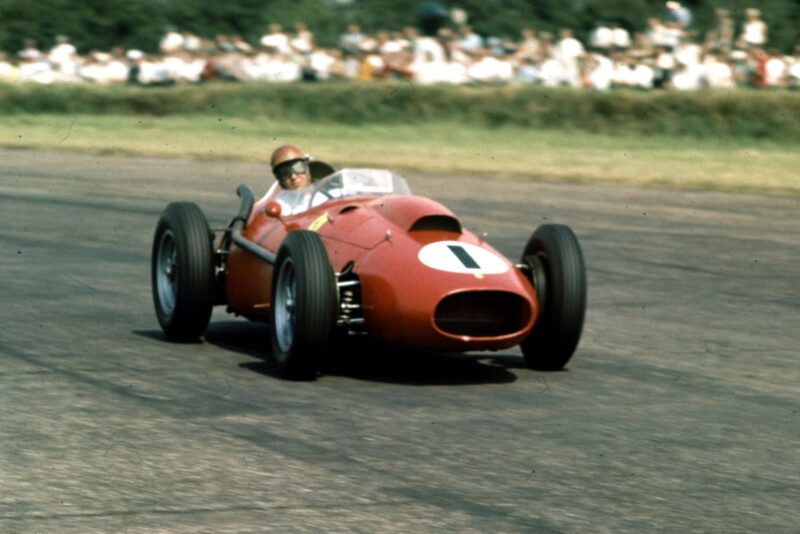
Peter Collins in his Ferrari Dino 246.
Motorsport Images
That the race was going to be a British benefit was almost a certainty from the practice times, with three different makes of green car in the front row and only one red car. After some of the supporting events had run themselves out the Grand Prix cars lined up on the grid as follows:
All three Vanwalls were using alloy rear wheels and wire-spoke front ones, and the car Moss had was his Reims one with bracing struts to the tops of the king-pins. Schell and Behra both had 1958 B.R.M.s, now with modified oiling systems, having the oil tank in the cockpit on the left of the driving seat and a large oil-cooler on the left of the engine with a ducted air-flow through it; the heat-exchanger layout being discarded, as it was found that the oil was making the water too hot. The three Ferraris were Dino 246 models, all using the F. I chassis with large-diameter bottom frame tubes, and Collins and von Trips both had large petrol tanks on the left of the driving seat. Hawthorn’s car had only a rear tank and he had discarded his wrap-round Perspex screen, retaining only a tiny rectangular aero-screen. The three Coopers were identical, with double rear wishbones and disc brakes, only Salvadori having the 2.2-litre engine, Brabham and Burgess having 1,960-c.c. engines, while Trintignant was driving the Walker Argentine-winning car with leaf-spring front end. Allison had the old Lotus, Hill the 1958 with near-horizontal engine, and Stacey, on his first F. I drive, in the 1958 car with the more upright engine, both these new cars being of 1,960 c.c. Of the rest, Bonnier was driving Scarlatti’s ex-works lightweight 1957 Maserati, Shelby the Centro-Sud car he drove at Reims, and Gerini his ex-Piotti car, and to complete the field were the two Ecclestone-owned Connaughts, Bueb in the “Dart” and Fairman in the normal Syracuse model. A third B.R.M., driven by Masten Gregory, should have made a field of 21 cars, but he unfortunately injured himself during practice when he crashed the Ecurie Ecosse Lister-Jaguar.
When the flag fell Hawthorn made a rather hesitant start and, though Moss led away, Collins shot through from the second row and took the lead on the opening lap. One has come to expect Collins not to bother to race too hard these days, but once out in front he really motor-raced in a big way, and though Moss had the Vanwall in full-lock slides round many of the corners and was driving as hard as he knew how, he could make no impression on the leading Ferrari. Hawthorn was backing up his team-mate by lying third, so Moss was in a difficult position, trying to catch Collins and trying not to be caught by Hawthorn. It was very clear that the two Ferraris were handling fairly happily with a full load of fuel and both drivers were doing some pretty broadsliding through the bends. After the excitement of the opening two or three laps Collins was setting a hot pace, Moss was trying to hang on and Hawthorn was a bit perturbed to see oil occasionally squirting out of the left side of his bonnet. Schell, who was in fourth place, was also worried, for his oil temperature was rising high and at the same time the pressure was sinking, so it was not long before Lewis-Evans came up into fourth place, but the third Vanwall, driven by Brooks, was getting nowhere. Just behind there was a cut-throat dice going on between Salvadori, von Trips, Hill, Brabham and Behra, and after a few laps the two Coopers, driving very nicely as a team, began to get the upper hand. This battle went on from lap 13 and so furious was it that the whole bunch were closing rapidly on Brooks and Schell, so that on lap 12 Schell found himself in the midst of it all, and the following lap they were all round Brooks. The two Coopers came out on top and for a while Brabham led this gaggle with the 2-litre car, but on lap 16 Salvadori went ahead and the very next lap Graham Hill dropped out of the battle and retired. The Lotus gearbox was burning his backside and then the oil pressure began to sink in the engine, so he called it a day, wishing Chapman would leave a little more clearance around the driving seat. Meanwhile Collins was pressing on, with a frustrated Moss doing all he knew to catch him and Hawthorn sitting back in third place awaiting developments. The tail end of the field was already well and truly lapped, Shelby, Burgess, Bueb and Gemini all having been passed by Collins, while Fairman had withdrawn a Connaught that had been sick ever since it arrived at Silverstone. Hill had barely retired when Behra came in with a soggy tyre; incredulous though it may seem, this was caused by hitting a hare, one of its bones piercing the Dunlop. Behra had never really been in the hunt and lost interest in the race after that, the car being withdrawn. Shortly after this Allison retired with sinking oil pressure, he having shown none of the practice speed, and Stacey went out with overheating, so that once again the Hornsey team did not exactly inspire anyone. Trintignant shot smartly into his pit on three cylinders, but before the mechanics could do anything the engine fired on four cylinders again and the driver shot off again.]
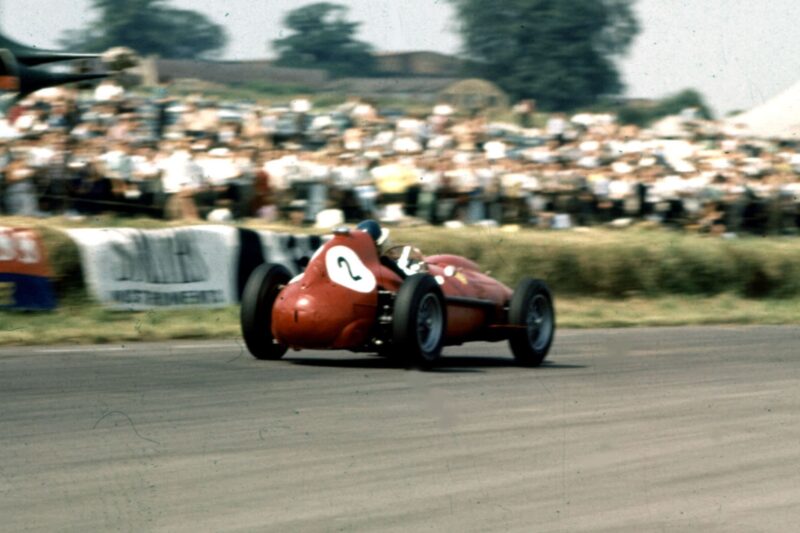
Mike Hawthorn piloting his Ferrari Dino 246 to 2nd place.
Motorsport Images
Hawthorn’s waiting game did not have long to pay off, for on lap 26 Moss passed the pits amidst a big cloud of blue smoke and turned smartly into the paddock. There was no need to look under the bonnet, the Vanwall engine had burst in a big way and Ferraris were now in full command of the race. Almost at the same time as this happened, Salvadori overtook Lewis-Evans and found himself in third place, while Brabham was still leading von Trips, and then came Brooks, seemingly completely off-colour. The race as such now developed into a high-speed procession dominated by Ferraris, the only anxious moment being when Hawthorn came into the pits on lap 44 crying “Olio,” and in double-quick time oil was poured into the tail tank and he was off again before Salvadori hove into view in the third-place Cooper. Collins lapped Brooks but it had no effect on the Vanwall driver, and then he lapped Schell’s B.R.M., but that was a different story. Having been going comparatively slowly for a time the B.R.M.’s oil temperature had dropped, so Schell now tucked in behind the Ferrari and tailed Collins remorselessly. This had the desired effect of drawing him closer to Brabham and von Trips, who were not far ahead having their own private battle. Ferrari were rather embarrassed by having their third car led by a 2-litre Cooper and urged on the German driver, but though he closed the gap he could not overtake Brabham for, apart from losing oil, the Ferrari brakes were pulling badly to the right. On lap 59 the effort was finished and von Trips coasted into the pits, where mechanics restarted the engine and then hastily switched off and wheeled the car away; all the bearings had gone. All this time Schell had been drawing closer, sucked along by Collins, until the Ferrari driver got tired of working for B.R.M. and slowed right down and waved Schell by, whereupon Schell went ahead and then caught and passed Brabham, having a last-minute fling with steadily rising oil temperature again. Just ahead of him Lewis-Evans was beginning to pile on steam in an attempt to catch Salvadori, who was suffering from a high cockpit temperature but driving hard nevertheless. The tail end of the field was getting very depleted, both Gerini and Bonnier going out-with gearbox troubles, though Shelby was still circulating on his own and enjoying himself immensely. As the race came to a close, Lewis-Evans had the nose of his car sniffing at the tail of Salvadori’s Cooper but he had left his efforts too late and he just had not got the speed, nor was there sufficient straight for him to get by, and on the corners the Cooper was faster, especially leaving them.
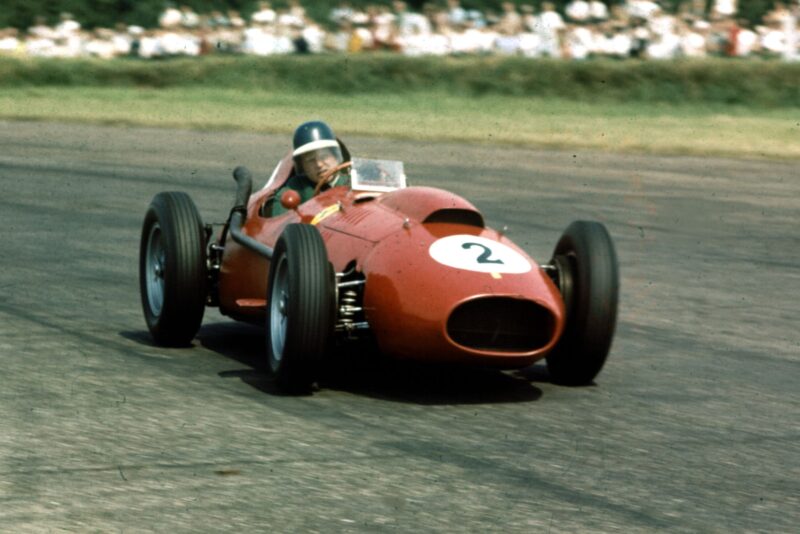
Mike Hawthorn in a Ferrari Dino 246
Motorsport Images
Collins and Hawthorn virtually toured home to win a most resounding and very unexpected win for the Scuderia Ferrari, while Salvadori scraped in third with the Vanwall pressing hard right up to the chequered flag, while Schell arrived fifth after an erratic drive, followed by Brabham, who had done mighty things with the 2-litre engine. A distinctly unhappy Brooks, who had been off form the whole race, was a lap behind, and the only other two finishers were Trintignant and Shelby. Collins had led for the entire 75 laps and done a real job of work, driving with that spirited air of full-opposite-lock that he enjoys so much, and which recently scented to have gone from his driving.—D.S.J.
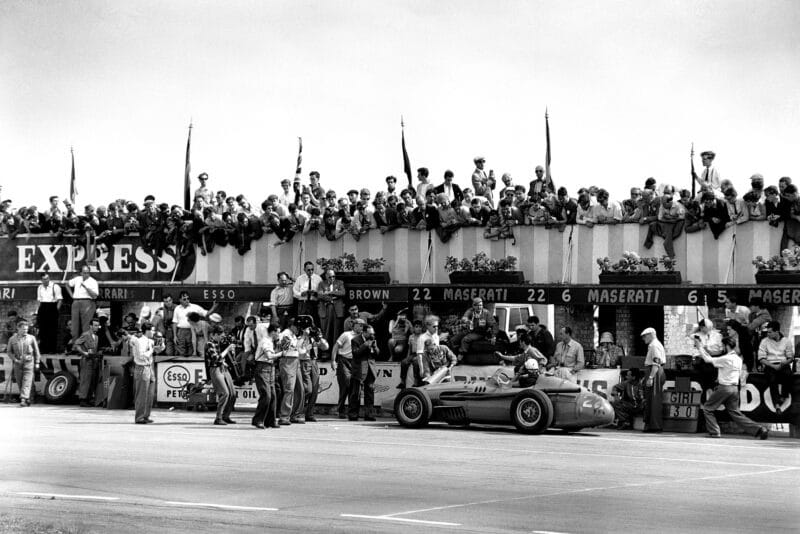
Jo Bonnier pulls into the pits in his Maserati 250F.
Motorsport Images
Results:
11th British Grand Prix Formula 1—75 laps—362 kilometres—Warm
1st: P. J. Collins (Ferrari V6) . . . 2 hr. 09 min. 04.2 sec.—163 k.p.h.
2nd: J. M. Hawthorn (Ferrari V6) . . . .2 hr. 09 min. 28.4 sec.
3rd: R. Salvadori (Cooper 2.2 litre) . . . 2 hr. 09 min. 54.8 sec.
4th: S. Lewis-Evans (Vanwall) . . . 2 hr. 09 min. 55.0 sec.
5th: H. Schell (B.R.M.) . . . 2 hr. 10 min. 19.0 sec.
6th: J. Brabham (Cooper 1.9 litre) . . . 2 hr. 10 min. 27.4 sec.
7th: C. A. S. Brooks (Vanwall) . . . 1 lap behind
8th: M. Trintignant (Cooper 2.0 litre) . . . 2 laps behind
9th: C. Shelby (Maserati 250F) . . . 3 laps behind
Fastest lap: J. M. Hawthorn (Ferrari), on lap 50. in 1 min. 40.8 sec.-168.23 k.p.h.
Retired: J. Fairman (Connaught), sick car. lap 8; G. Hill (Lotus), burnt driver and oil pressure, lap 18; J. Behra. (B.R.M.), flat tyre and driver deflated, lap 20; L. Bueb (Connaught), sick car, lap 20; A. Stacey (Lotus), overheating, lap 20; C. Allison (Lotus), oil pressure, lap 22; S. Moss (Vanwall), engine trouble, lap 26; L. Burgess (Cooper), clutch, lap 41; C. Gerini (Maserati), gearbox, lap 44; J. Bonnier (Maserati), gearbox, lap 44; W. von Trips (Ferrari). engine, lap 60.
Apart from this short, sharp Grand Prix, there were three supporting races, one for sports cars and another for saloons before lunch, and a 500-c.c. race to lower the curtain.
The Sports-Car Race, over 25 laps, was divided into three capacity classes, up to 1,100 c.c., 1,101-2,000 c.c. and over 2,000 c.c. In the small class Elva and Tojeiro challenged Lotus, but in the middle category, with two Willments non-starting (Brabham and Lewis-Evans were down to drive them), only the Maserati-engined Parsons and Naylor’s J.B.W. challenged the trio of Team Lotus 1 1/2-litre cars and Salvadori in Coombs’ 2-litre Lotus. It was expected that the big category would resolve itself into a battle between Moss in a works Lister-Jaguar and Masten Gregory, the American driver who drove so well at the May Silverstone Meeting, with an Ecurie Ecosse Lister-Jaguar. However, in practice on the Thursday, Gregory was a victim of “cockpit error” when attempting to overtake two slower cars at Woodcote Corner. He left the course on the outside and, attempting to spring out as the Lister slid backwards into the bank, was considerably injured, while the car folded up. Moss therefore faced opposition mainly from another American, Walter Hansgen, in the other works Lister, although Ecurie Ecosse were fielding Bueb in a Tojeiro-Jaguar and Ireland in a D-type Jaguar, all these Jaguar-powered cars with 3.8-litre engines.
In the event, Moss led all the way, pursued by Allison’s Lotus Fifteen, and Hansgen’s Lister. After nine laps Hansgen retired, when 4 sec. behind Moss, it was said with a dropped valve, and Salvadori took third place, moving up behind Moss after 13 laps, although the big Lister had a comfortable 10-sec. lead. Behind the two Lotus cars Halford had his Lister in fourth place, but on lap 16 Bueb passed him in the Tojeiro. Allison was trying very hard, setting a new Class F sports-car lap record of 99.41 m.p.h., the speed Moss had done in the 3.8 Lister. But Salvadori’s larger engine kept him ahead. Hill had an unhappy ride in his works Lotus, and Lovely, in the other works Lotus, retired when a con.-rod broke. Stacey was doing splendidly in a 1,100 Team Lotus, displacing Halford’s 3.4 Lister from fifth place.
The saloon-car race suffered from a small entry, the field being further depleted when Sopwith’s 3.4 Jaguar, in the lead, shed a wheel. Out of 120,000 spectators only 119,999 went home, because the Jaguar’s wheel hit one, breaking one of his legs. Thus, after 11 of the 17 laps, Hansgen in Coombs’ 3A Jaguar led from Sir G. Baillie’s and Crawley’s Jaguars, in which order they finished. J. M. Uren rolled his Ford Zephyr over, necessitating hurried work by Fords to repair it for the next round of the B.R.S.C.C. Saloon Car Championship. Sparrowe’s slow D.K.W. slid and rolled over also. Of those still on their wheels, the 1.5 Rileys of Leston and Grace put Sears’ Austin A105 to shame, while amongst the “little fellows” Bob Gerard, by dint of long experience and an Alexander Conversion, just kept his Austin A35 ahead of Adams’ Speedwell Conversion A35. Sprinzel’s A35 retired with loss of water and Hill’s never went very fast-all the Speedwell A35s had standard manifold, single Anita carburetter, solid-skirt flat-top pistons, Speedwell head and a compression-ratio of about 9 1/2 to 1. Gerard’s A35 had an Alexander head, a 32-mm. Solex carburetter, standard manifold and pistons, and a 9-to-1 compression-ratio. The 1.5 Rileys of Leston, Grace and Walker won the Team Prize.
The 17-lap 500-c.c. racing-car event commenced as a duel between Lewis-Evans and Taylor, both in Beart-Coopers. After Taylor had trouble, finally retiring, Parker came up into second place, pursued by Bridger.
Congratulations to John Eason-Gibson for having dropped the dangerous Le Mans start from the sports-car and saloon-car races.—W. B.
